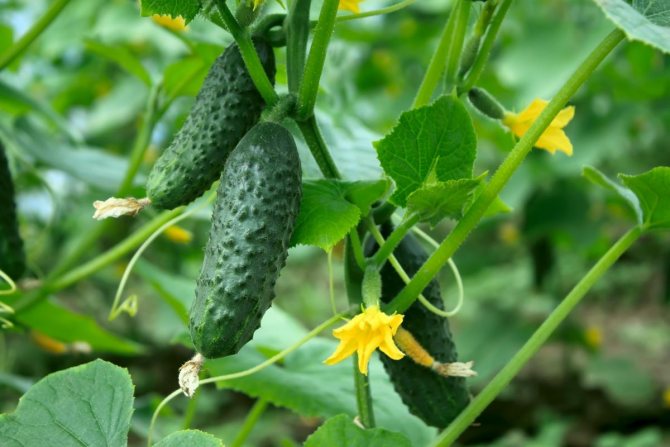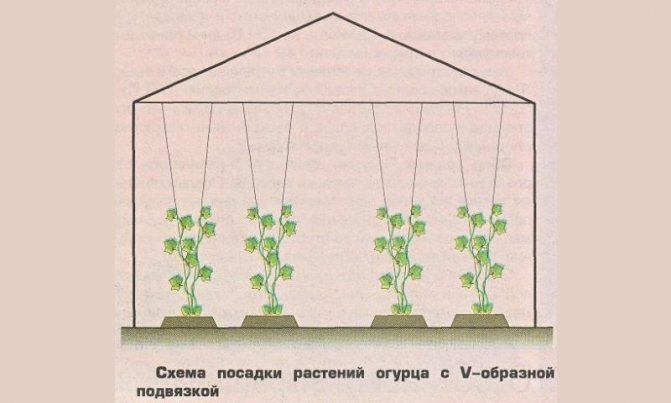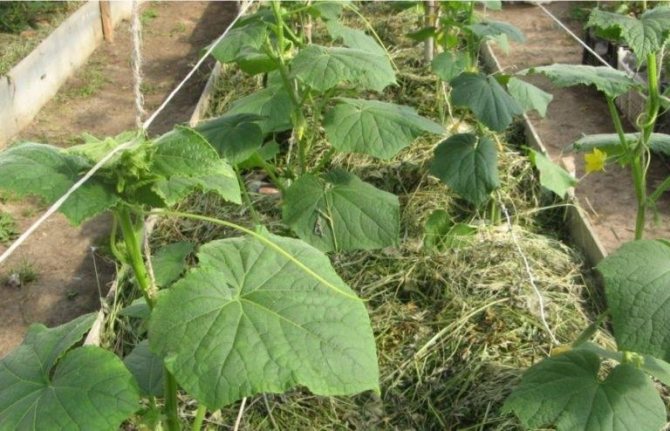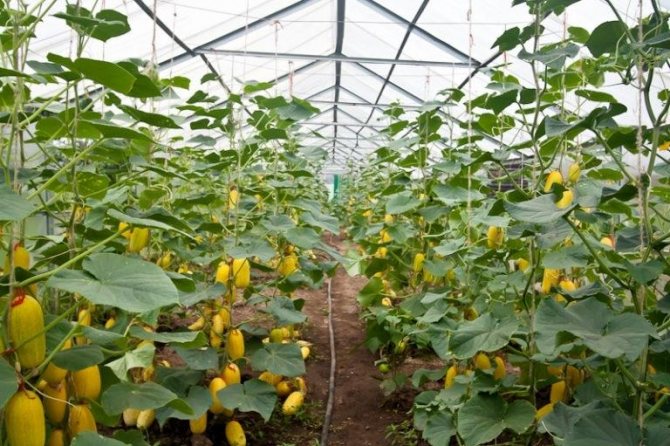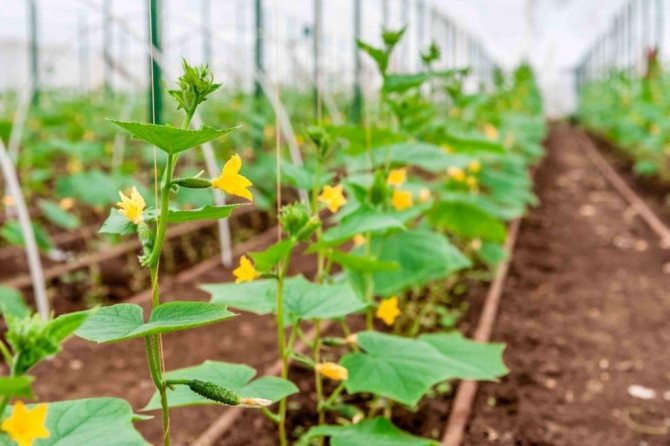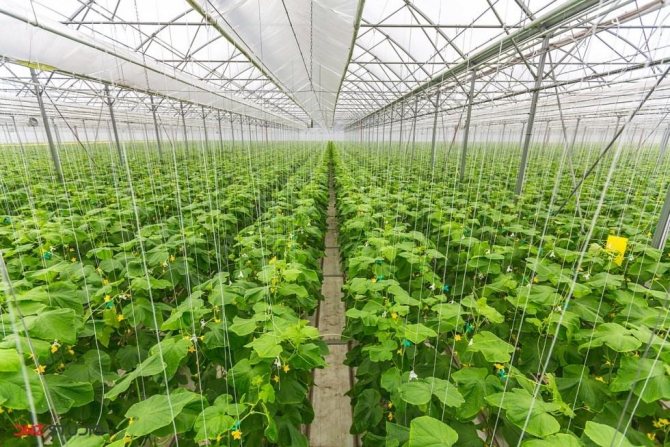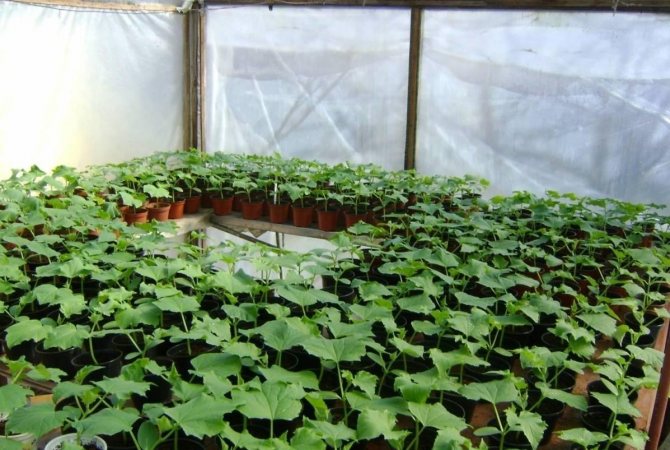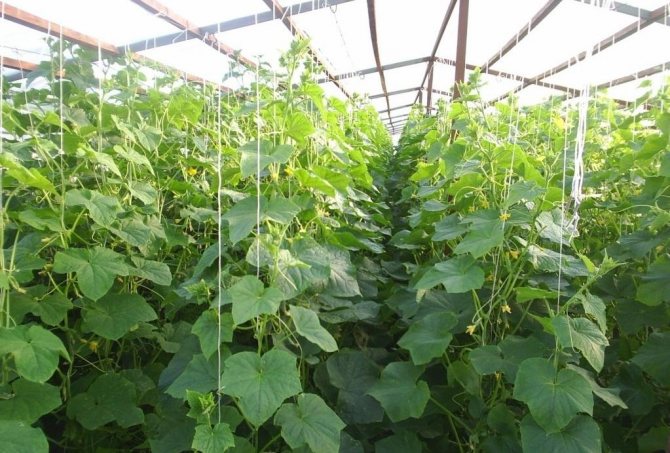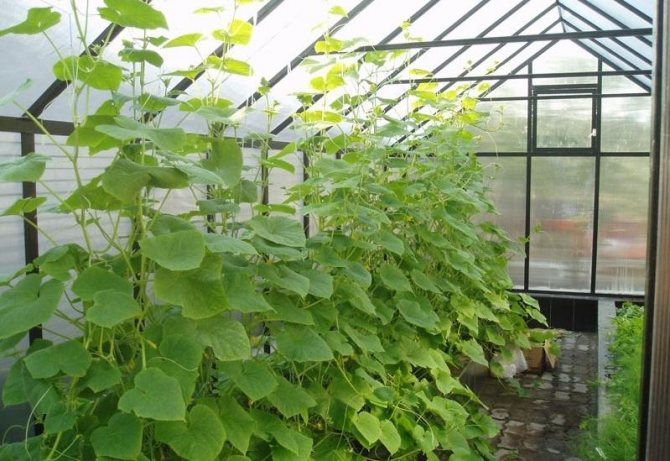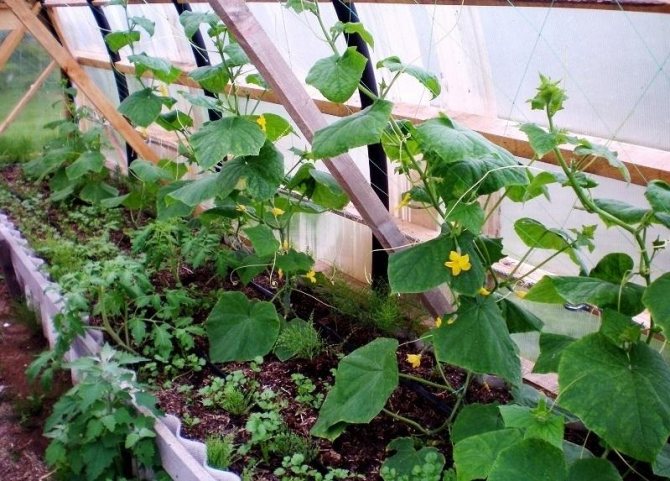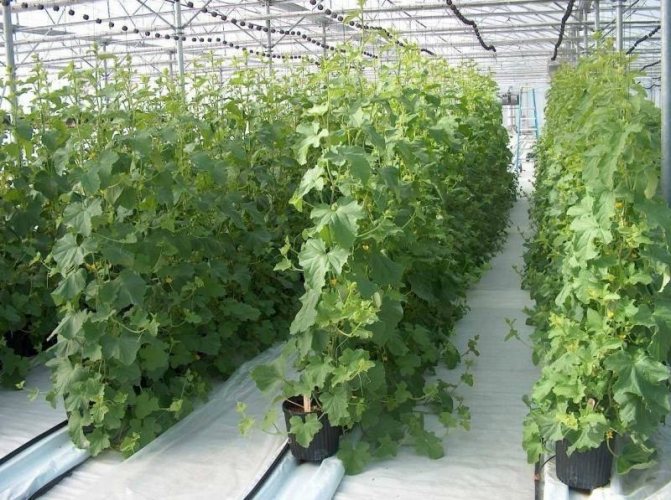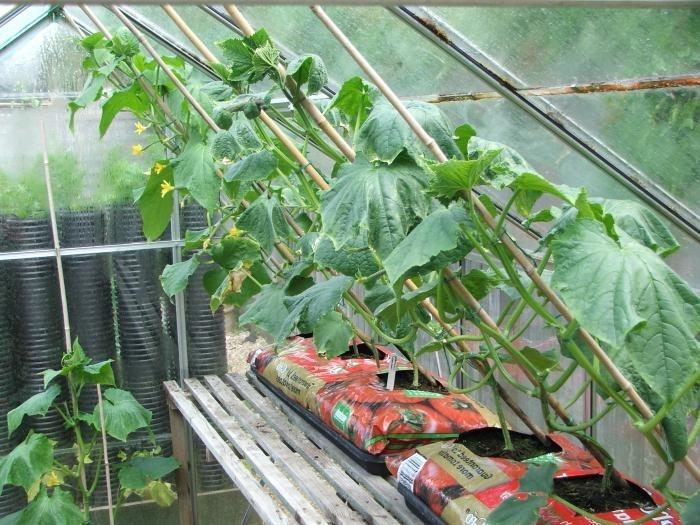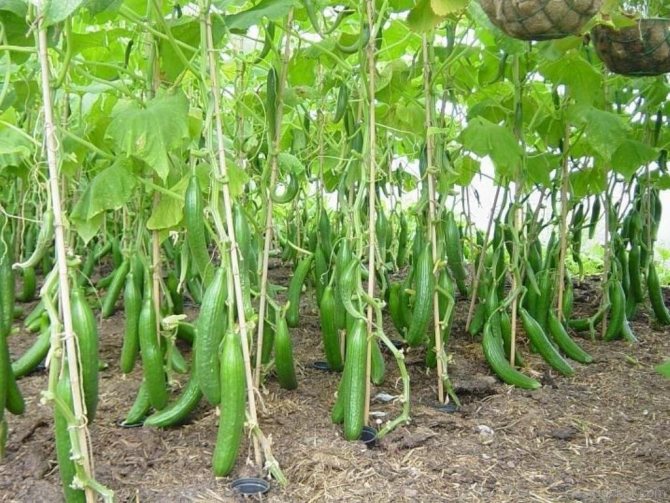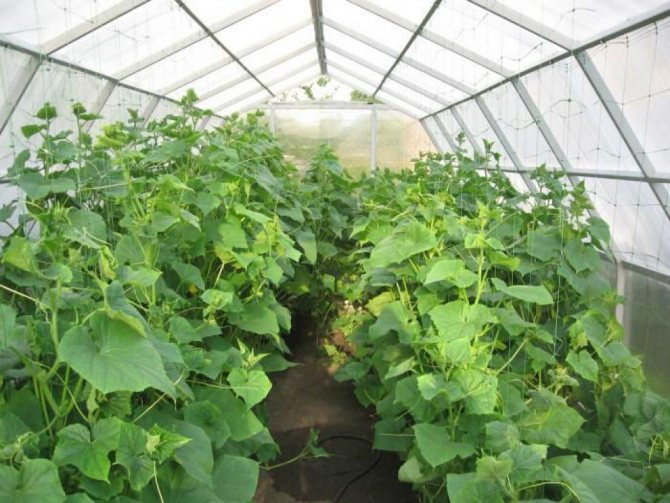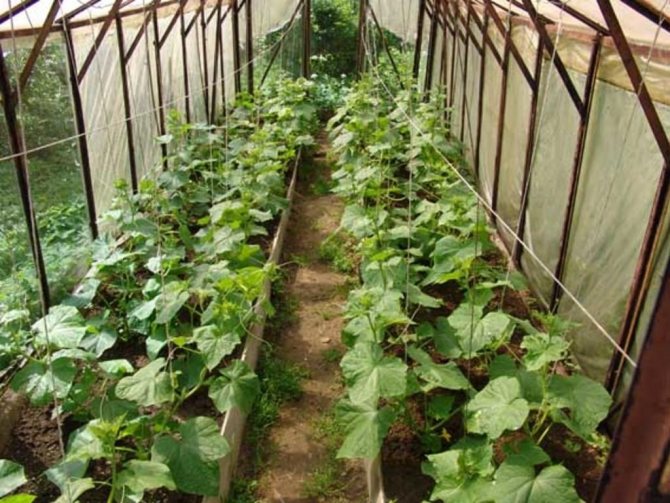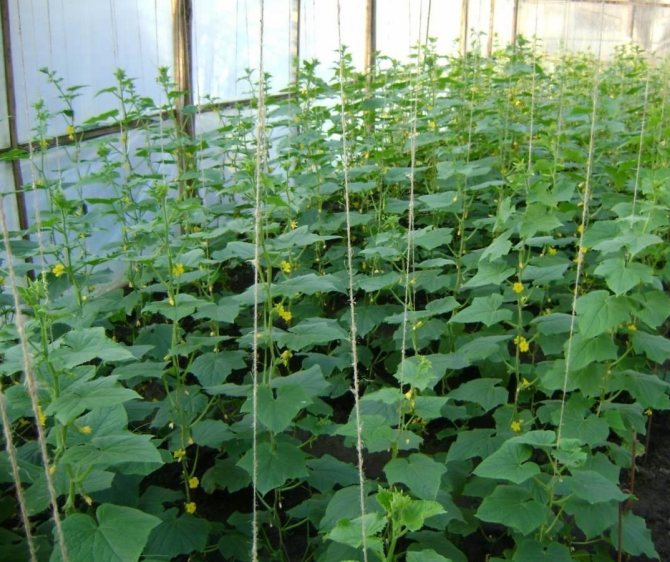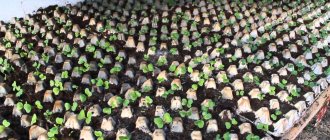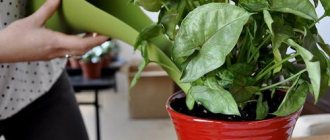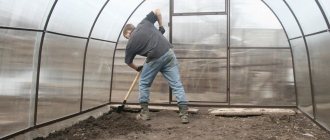What is the distance to plant cucumbers in the greenhouse? This question interests every summer resident. It is impossible to imagine a garden plot without cucumbers in a greenhouse. This culture has long been valued for its beneficial properties and excellent taste. For several millennia, cucumbers have been used in medical practice and cosmetology. Plants can be planted both indoors and outdoors.

The first step is to determine the stocking density. If the plants are too close to each other, there is a high probability of getting a bad harvest. As the planting grows, they will intertwine with each other, which is dangerous for this culture.
Greenhouse cucumber bed width
The first step is to properly prepare the greenhouse itself. If possible, it is installed on an area located evenly or with a slight slope to the south or southeast. Provision should be made for ventilation on hot summer days. Since cucumbers are native to India, a warm and humid microclimate in a greenhouse is favorable for them.
When the greenhouse has already been built, you can start arranging the beds. It is necessary to prepare the soil in it for the future rich harvest.
Any greenhouse soil requires disinfection before subsidence. If the greenhouse has been used for more than a year, then processing can be carried out in the fall. Cucumber prefers soil rich, saturated with organic fertilizers.


So, what is the best distance to plant cucumbers? Depending on the length and width of the greenhouse, gardeners use several types of ridges on which cucumbers can be planted in a greenhouse or greenhouse. The first option is ridges that rise above the ground. Made from available lumber. Sand, sawdust, manure or straw are poured onto the bottom as drainage. The top layer is soil mixed with compost. The height of such a box is 25-30 cm. The width of the beds can be up to 100 cm, the length depends on the size of the greenhouse, the location of the beds inside it and the size of the passage between them.
Another option familiar to all is soil ridges. The height of such a ridge is also up to 30 cm, width is 100 cm. The maximum length is up to 5 meters. Recently, the "warm" cucumber bed has become widespread. It will not be difficult to make it, and the effectiveness has already been tested by amateur gardeners.
Stages of forming a warm bed:
- Dig a trench with a depth of at least 30 cm, a width of 60 cm, and the length is individual;
- The bottom is laid out with branches, sprinkled with sawdust, a layer of straw is poured on top;
- Pour manure diluted in warm water;
- A layer of soil is poured on top;
- A few days before planting cucumbers, spill the ground with boiling water and cover with foil.
There are several ways of arranging such beds, but all are characterized by the use of manure as fertilizer and biofuel. The preparation of the beds in the greenhouse for cucumbers is not carried out on the eve of planting, but in advance. If the size of the greenhouse is large enough and funds allow, then at the stage of forming the beds, you can think over an irrigation system. Simultaneously with the preparation of the beds, you can grow cucumber seedlings from the selected seeds.
Common mistakes
Any improper care of cucumbers, irregularities in watering, incorrect planting distance or lack of feeding, ultimately leads not only to a decrease in yield, but also to the complete death of plantings.Common mistakes include:
- poor quality seeds;
- non-compliance with sowing rules;
- wrong conditions;
- excess nutrients;
- an abundance of barren flowers.
All seed should be approximately the same size, i.e. calibrated. Freezing during storage is not allowed. Mandatory absence of any signs of disease. Presowing preparation includes soaking, hardening, processing with special preparations. If these conditions are not met, poor germination or developmental delay is possible.
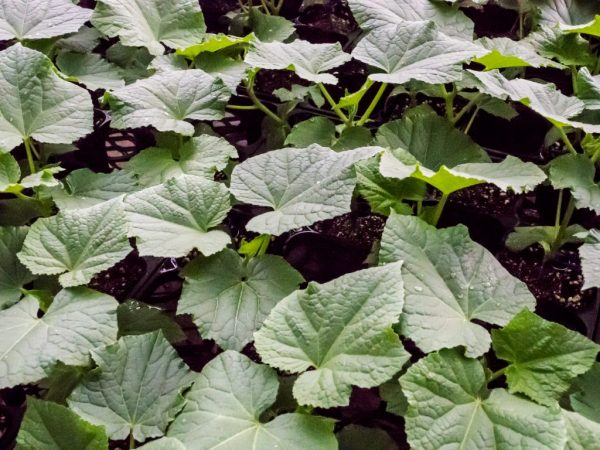

Maintain your plants well
In the case of incorrect sowing, even if all the seeds were selected with high quality, the desired result will not be. The correct formation of the beds, the distance maintained according to the technology, the heated soil, especially when planting directly into the open ground, will allow you to get many shoots. It is recommended to immediately eliminate all pathogens.
Each variety or hybrid has specific growing conditions. Therefore, before starting, you should carefully study them and find out all the features of this species. Respect the recommended spacing and care conditions for each planting method. For example, in order to get a good harvest from bee-pollinated varieties, you need to know that you cannot plant them in a greenhouse, that there are special requirements for the distance from the edge of the ridge to the walls of the greenhouse.
It is the wrong distance and poor quality planting material (fresh, poorly heated seeds of the last year) that lead to an abundance of barren flowers. This should be given special attention. Barren flowers are male flowers that cannot form fruit. This leads to a decrease in yield and quality of the final product.
Precautions
To prevent the appearance of a wasteland, you must:
- do not allow a tight fit;
- avoid thickening of the bushes;
- place crops in a shaded place;
- observe temperature and climatic conditions.
For 1 sq. M. there should be no more than 1-2 plants. Ensure that all bushes are ventilated and receive light evenly.
Planting scheme for cucumbers in the greenhouse
Cucumber varieties bred by domestic and foreign agronomists are very diverse.
But they are divided into three main groups:
- Parternocarpic cucumbers, which form a fruit without pollination;
- Self-pollinating cucumbers, which have both stamens and a pistil in one flower;
- Traditional bee-pollinated varieties that need the help of bees to pollinate.


Depending on the selected variety, a scheme for planting cucumbers in a greenhouse is selected. Bee-pollinated varieties are planted according to the scheme - 35x50 cm. 35 cm is the distance between plants, and 50 cm is between the rows of cucumbers. Parternocarpic and self-pollinated cucumbers are planted at the rate of 3 plants per 1 m². Too sparse landing is also not advisable.
Yield enhancement technologies
To increase the yield of cucumber lashes, you need to remember the following conditions:
- the soil in the beds should be moist all the time;
- air humidity cannot be less than 55-60%;
- regular feeding.
Correctly applied fertilizers can significantly increase the yield of planted cucumber varieties. Before flowering, top dressing is applied to the soil, containing a large amount of nitrogen. When ovaries appear, mineral dressings containing phosphorus and potassium are added under the lashes of this vegetable crop.
You can alternate organic and mineral supplements.
Distance between cucumbers in the greenhouse
Given the width of the beds, the planting of cucumbers can be tapered: two rows per bed with a distance between plants of 40-50 cm.That is, if the width of the bed is 100 cm, then we retreat from each edge by 30 cm and 40 cm remains between the rows of cucumbers in the garden.


Wherein:
- Plants of one row can be located opposite plants of another row;
- Plants in rows can be staggered.
The use of a staggered order of planting of cucumbers is more expedient. In this case, aeration is improved, that is, air flow and illumination into the greenhouses. This is important for the development of plants, since the leaves of cucumbers are large and "fluffy", they hold water for a long time, and this leads to decay and loss of the leaf.
When grown on a balcony
You can even get a crop by placing seedlings or seeds in the ground on the balcony. This method assumes the use of wide and deep containers. One plant should have at least 5 liters of fertile land. Sowing of seeds is carried out in containers at least 80 cm long and at least 40 cm high. The distance between the cucumbers is about 30 cm. You can place 1-2 seeds in each hole, deepening them no more than 2 cm. If each seed germinates, the less strong shoot will need to be pulled out.
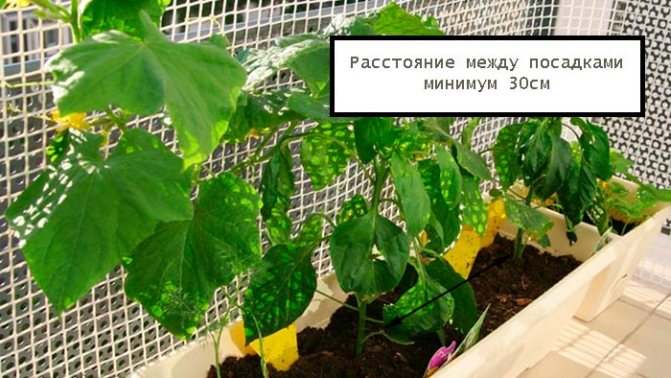

Location of cucumbers in the greenhouse
Cucumbers in a greenhouse require daily care: watering, feeding, weeding, garter and bush formation. The cucumber is a liana in origin, so it needs to catch on to something. Use a vertical or horizontal plant tie. Horizontal is used in greenhouses and greenhouses of low height.
On both sides of the beds, wooden or metal posts are strengthened, and a wire or rope is pulled between them in rows.
The stems are hooked onto a horizontal rope so that they continue to grow upward rather than lying on the ground. The vertical garter is built on the opposite principle. On a frame of two slats, one of which is attached to the ceiling, and the other lies on the ground, the ropes are pulled vertically. Cucumbers stretch upwards along them.
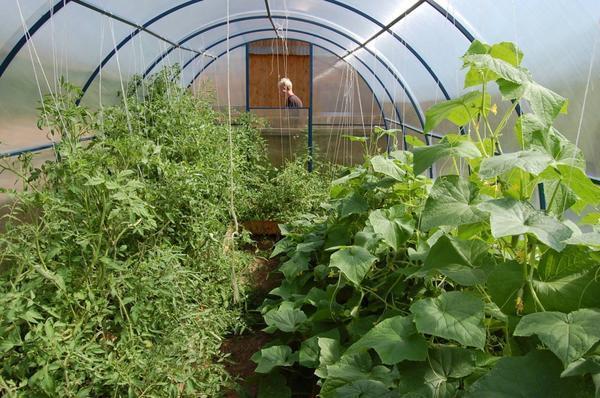

Another important point when growing cucumbers in a greenhouse is the location of other plants next to it. For many gardeners, it is possible to build only one greenhouse due to limited space or funds. Therefore, I want to make the most of it. The easiest way seems to be to plant cucumbers and tomatoes together. These vegetables tolerate each other rather than love each other.
Cucumbers will be more comfortable with:
- Peppers or eggplants, the cultivation of which requires the same level of humidity as for cucumbers - 80%, the illumination and ventilation of the greenhouse;
- Herbs, salad or seedlings;
- Beans and legumes (legumes improve soil quality).



